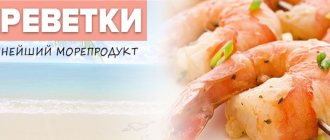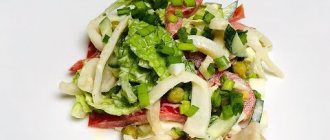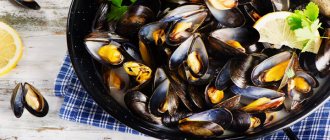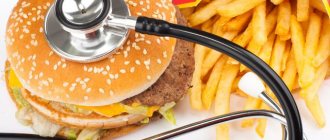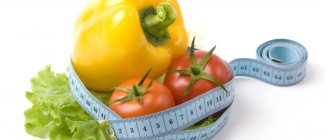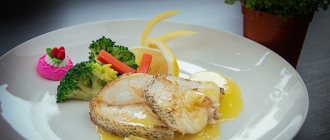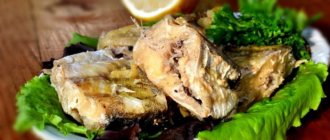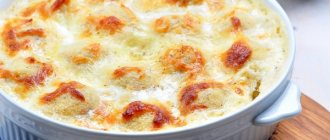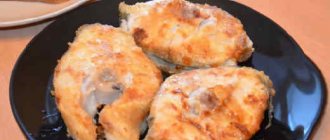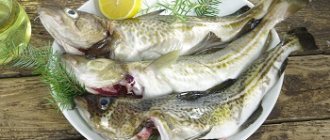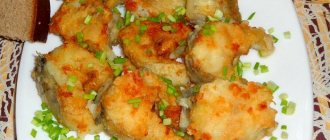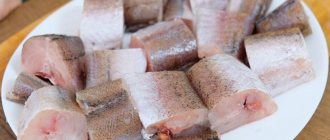Lose weight up to 4 kg in 6 days. The average daily calorie content is 900 Kcal.
Since ancient times, people have been eating the gifts of nature - not only plant and animal food, but also the inhabitants of lakes, rivers, seas and oceans. And today the list of healthy and tasty food is rightfully headed by seafood.
For information, all edible inhabitants of the world's oceans, except fish, are considered seafood. Their typical representatives on our table are shrimp, squid, crayfish, crabs, lobsters (lobsters), octopus, lobsters, oysters, mussels, rapana, scallops, kelp. All seafood is a real storehouse of protein, iodine, easily digestible by our body, many vitamins and microelements, and polyunsaturated fatty acids.
Seafood, along with its exquisite taste, helps us normalize metabolism, increase vitality, and prevent diseases of the musculoskeletal system. By the way, scientific research has proven that the longevity and beautiful appearance of the Japanese is the result of the abundant presence of ocean gifts in their diet.
In some seafood diets, their developers include fish in the menu. Today we will introduce you to some weight loss techniques based on the consumption of seafood. Choose any diet for yourself. The diet menu will differ not only in taste, but also in benefits.
Seafood Diet Requirements
A seafood mono-diet is the shortest option for losing weight. This diet course lasts 2-4 days, weight loss is 1-2 kilograms. Prolonging the diet is highly undesirable. According to the rules of the mono-diet, you can only eat seafood and fish in small portions (about 250 g) three times a day. For dinner, you can slightly reduce the serving size (up to 150 g) and drink a glass of low-fat kefir. An afternoon snack consisting of a glass of this fermented milk drink is also provided. Eating fruits, vegetables and other foods is prohibited. You can use freshly squeezed lemon juice to season your dishes. Choose lean fish (for example, cod, pollock, hake, crucian carp). Drinking diet - still water, green tea, black coffee, herbal infusions. Sugar is prohibited.
Seafood diet
, the key dish of which is
seafood soup
, lasts 6 days. Weight loss - 3-4 kg. In addition to seafood soup, you are allowed to eat vegetables, fruits, hard cheese, freshly squeezed juice, bran bread, unsweetened cereal, and yogurt. It is recommended to have four daily meals. When preparing dishes, you cannot use fats and oils, but you can add lemon juice to them. Salt, sugar in any form, and alcohol are strictly contraindicated. How to make soup? You can find many recipes for dietary seafood soup on the Internet. We won’t describe each of them now; it will be easier for you to choose the option you like for preparing the soup. Imagine, use different ingredients every day, and then such a soup will become part of your diet not only for the duration of the diet, but will become a favorite dish for a long time.
squid diet has been developed for squid lovers
. Weight loss on it, on average, is 1 kg per day. All seven days the same three meals a day are provided, including squid, non-starchy vegetables, carrot and apple juice, apples, low-fat cheese. It is recommended to avoid snacks. You can drink tea, coffee, but without adding sugar.
Navaga is an excellent fish for children's menus
This is a small coastal fish from the cod family. The structural feature of navaga is the almost complete absence of small bones, which makes it indispensable in the diet of small children. Sea fish contains little fat and many beneficial microelements and vitamins.
Navaga has been used in Russian cuisine since ancient times, so many people are familiar with it. In most cases, fish is fried in a frying pan or soups are made from it. In addition, you can make delicious meatballs from the meat, which will appeal to those who do not like small fish bones. There are also many recipes for stuffed navaga, where mushrooms, vegetables or cheese are used as filling.
Seafood diet menu
Example of a seafood mono-diet for 4 days
Breakfast: 250 g of boiled shrimp, seasoned with lemon juice. Lunch: salad of 250 g of seafood (rapana, mussels, shrimp, kelp), seasoned with lemon juice. Afternoon snack: a glass of kefir. Dinner: 150 g of boiled lean fish and a glass of kefir.
Example of a seafood diet for 6 days
Breakfast: a couple of toasts from bran bread; a portion of seaweed salad; a cup of green tea. Lunch: bowl of seafood soup; salad from any vegetables; apple. Afternoon snack: freshly squeezed fruit juice; grain bread; banana; low-fat yogurt. Dinner: steamed fish cutlet; 2 tomatoes; a pear or a couple of plums.
Example of a squid diet for 7 days
Breakfast: salad (we use cucumbers, tomatoes, squid); freshly squeezed carrot juice. Lunch: boiled squid; two fresh or baked apples. Dinner: boiled squid; a slice of low-fat cheese; Apple juice.
What seafood can you eat when losing weight - list
The sea gives people many types of useful products. Some of them are affordable, others are expensive delicacies. What goes on general sale includes:
Lobsters, crabs, lobsters
This dietary meat contains valuable protein in the amount of 16-19% of weight. The amount of fat is minimal - up to 2%. A characteristic feature is the complete absence of carbohydrates. Many recipes for first and second courses are based on these seafood.
Shrimps
The amount of protein is comparable to the previous group and is approximately 19-22 g/100g. With a low fat level (up to 1.5 g), shrimp contain some carbohydrates - 1-15 g. Special fasting diets are often based on shrimp.
Squid
In terms of proteins, they are slightly inferior to lobsters and shrimp (16 g), but are ahead in the amount of carbohydrates (3 g). The fat level is also minimal (1.5 g). Squids occupy a significant position in dietary nutrition. Main courses and salads are prepared from them.
Octopuses
They are often put on the same level as squid in terms of nutritional value. However, the two products have subtle differences. Octopus meat contains up to 15 g of protein, about 1 g of fat and only 2.2 g of carbohydrates. This seafood is ideal for preparing cold and hot appetizers and main courses.
Mussels
The widespread delicacy is distinguished by a slightly lower (compared to other seafood on the list) protein content (12 g), a slightly higher level of fat (2 g) and carbohydrates (3.5 g). The most common recipes for soups and salads based on mussels.
Oysters
In terms of nutrients, they even slightly “overtake” mussels. They contain only 9 g of protein, up to 2 g of fat, and 4.5 g of carbohydrates. Oysters are distinguished by their high content of omega-3 acids. Lovers of extraordinary dishes can treat themselves to this delicacy even if they are on a diet.
Fish
Lean marine fish are nutritionally similar to crabs and lobsters. The indicators fluctuate within the following limits: proteins - from 14 to 20 g, fats - from 1.5 to 3 g, there are no carbohydrates in meat. Sea fish is a common product both during a regular diet and during weight loss. Recipes from it are varied, the list includes appetizers, first and second courses.
Kelp
Seaweed differs from all the seafood described above in its low protein (0.9 g) and fat (0.2 g) content. The amount of carbohydrates is adequate to the indicator for squid and mussels (3 g). The main value of seaweed is its rich vitamin and mineral composition. The second merit of kelp is that it can partially replace salt in dishes.
Contraindications for a seafood diet
- A seafood diet is contraindicated in case of individual intolerance to fish and seafood, or in cases of disruption of the endocrine system.
- You should not go on such a diet during pregnancy, during breastfeeding, children and the elderly, during exacerbation of chronic diseases and in case of any serious health problems.
- Of course, you don’t need to turn to this method of weight loss if you simply don’t like the products offered by the diet.
- Before starting a diet, it is highly advisable to consult a doctor.
Octopus salad
You need to purchase: 250 g of boiled octopus meat, red and green bell peppers (half each), 1 large tomato, half an onion, 12 black olives, 2 tbsp wine vinegar, 5-6 tbsp olive oil. , parsley, salt, pepper. The octopus meat needs to be cut into pieces, the peppers and tomatoes into cubes, and the onion finely chopped. Place everything in a salad bowl. To make the dressing, whisk olive oil with vinegar, chopped parsley, salt and ground pepper. Season the salad, mix thoroughly and finally garnish with olives. You can also add boiled shrimp to this salad.
Advantages of a seafood diet
- The seafood diet is notable for the fact that, in addition to quickly adjusting your figure, it has a healing effect on the body.
- Proteins, vitamins, amino acids and microelements contained in seafood are of great value. Biologically active substances in seafood prevent the development of oncology, normalize metabolism, and strengthen the immune system.
- We absorb protein from seafood easier and better than protein from animal and poultry meat.
- Seafood contains a lot of polyunsaturated fatty acids, which improve brain functioning and lower bad cholesterol levels. In addition, the introduction of sea inhabitants into the diet has a positive effect on the functioning of the thyroid gland, reduces the chances of encountering various types of allergies, improves the functioning of the gastrointestinal tract, slows down aging and has a general strengthening effect on the body.
- In addition, seafood is a strong natural aphrodisiac that increases libido.
- If you love seafood, you will surely enjoy eating it every day. And by eating deliciously (even if not very plentifully), there will be no desire to break off the diet, and you will bring your goal to completion.
What are seafood and how are they useful?
Seafood is not only fish, but also a wide variety of inhabitants of the seas and oceans, which are quite edible and used in popular dishes. In addition, by choosing to lose weight on seafood, you have the opportunity not only to get a beautiful body, but also to significantly improve your health.
This is facilitated by a large amount of omega-3 fatty acids. And it does an excellent job of supporting the normal functioning of the cardiovascular system, improves hemoglobin production, and also accelerates metabolism and digestion.
Do not forget that seafood is a natural aphrodisiac that helps increase sexual attractiveness. And it is also very tasty and healthy.
In addition to Omega-3 fatty acids, seafood is rich in protein and a variety of nutrients, including:
- iodine;
- phosphorus;
- zinc
They contain copper, calcium and other trace elements.
The use of seafood in the food system, including dietary, allows you to improve your metabolism and significantly increase your vitality. Can help in the treatment and prevention of joint-related diseases.
However, despite the many positive aspects, it is still recommended to visit a nutritionist’s office to check for the presence or absence of an allergy to seafood.
Disadvantages of a seafood diet
- You still can’t lose significant weight by eating seafood, because following a diet for a long time is contraindicated.
- We also note that seafood cannot boast of being cheap, so this diet is not suitable for people on a limited budget.
- It is important to be very careful when choosing seafood. They may contain pathogenic bacteria, heavy metals, arsenic, and mercury. Remember the main rules that will protect you from dangers: freshness of seafood and mandatory heat treatment.
- Eating seafood may cause allergies, manifested by rashes and itching. There are also more severe cases of the body’s reaction to seafood, accompanied by swelling of the larynx, headaches and dizziness, even loss of consciousness. Remember about this risk and, if there was at least some hint from the body of not accepting such products, you should not eat them.
How to cook seafood
Cooking seafood is easy and quick, although there are certain tricks in this matter. For example, shrimp are sold peeled and in the shell. Those in the shell need to be boiled in salted water (2 tablespoons per 1 liter of water) for only 3-4 minutes. Cook peeled shrimp for 2-3 minutes, and use half as much salt for the solution.
If the shrimp are frozen, they are cooked for 5-10 minutes, depending on the size. Boiled shrimp should be cooled immediately; it is better to mix them with pieces of crushed ice. If the shrimp are large, you need to remove their intestinal vein, because it will give the meat an unpleasant taste. Unpeeled shrimp can also be steamed (in a pressure cooker - 4-5 minutes). Such meat will retain more nutrients and will be more tender.
It is also good to fry peeled shrimp in oil - butter or vegetable - with the addition of garlic (over high heat - 3-4 minutes), and bake it in the oven, pouring cream on it (only 15 minutes). They are even grilled (6-7 minutes, not forgetting to turn them over several times).
Squids are also sold chilled or frozen. The easiest way to prepare them is to boil the cleaned carcasses. To prevent the meat from turning purple-pink, throw the carcass into water heated to 80 degrees and leave in it for 5 minutes, do not bring to a boil. After this treatment, use the squid meat for salads or fry it additionally.
You can also fry its raw meat, using traditional rings breaded in flour. It is very important not to overcook, otherwise you risk getting rubbery, tough meat instead of tender. If you still “managed” to overcook the squid, add boiled water to it and simmer for another 20-25 minutes, only over low heat, then they will soften again.
To enjoy seafood, you don’t have to go to a restaurant; you can prepare simple dishes at home.
Mussels are always ready!
All mussels sold in our stores are completely ready to eat - since they spoil very quickly, they are immediately boiled, then canned or frozen. If you like shellfish in jars, choose a product with natural “preservatives” - vegetable oil or vinegar, without sodium benzoate and other chemicals. Those who prefer iced mussels will have to defrost them at room temperature first and only then fry or bake them. Remember: good mussels are always elastic and delicate in taste - if the product is bitter, it means that it was caught a long time ago and has lost the lion’s share of its beneficial qualities.
Crab Meat Casserole
Buy: canned crab meat 200 g, long grain rice 90 g, 1 small onion (finely chopped), 1 clove garlic (crush), vegetable oil 1 tbsp, chopped cilantro or parsley 2 tbsp, sauce soy 1 tbsp, milk 250 ml, eggs 2 pcs, salt and pepper.
Boil the rice in salted water for 12 minutes, remember to rinse with cold water and drain. Fry the onion and garlic in oil until golden brown (about 5 minutes). Stir in onion, garlic, rice, herbs, soy sauce, crab meat, and add milk. Salt a little and add pepper. Pour beaten eggs into this mixture. Place it in molds or molds (fill halfway) and bake in the oven for 25 minutes at medium temperature until golden brown.
Therapeutic diet for this pathology
The therapeutic diet is aimed at reducing the consumption of protein products of animal origin. The allowed amount is up to 1 g per 1 kg of body weight. It is imperative to maintain water balance, the amount of liquid you drink is up to 2 liters per day. As a liquid, you can use rosehip decoction, fruit juice, water with lemon, or alkaline mineral water. Alkaline water prevents the occurrence of nephrolithiasis. Salt consumption is limited, because it retains fluid in the body and disrupts lymphatic drainage. Diet therapy for gout is aimed at eliminating foods that are rich in purines.
Products that should be excluded:
- rich meat and fish broths;
- yeast baked goods;
- legumes;
- fatty fish, sprats, sardines, pike;
- offal;
- lard, lard;
- porcini mushrooms, champignons;
- sweets – cakes, pastries, sweets, chocolate;
- greens - spinach, sorrel, rhubarb;
- vegetables – asparagus, cauliflower, radish, radish;
- fruits – figs;
- cereals – white peeled rice;
- sausages, smoked meats;
- yeast products.
It is recommended to consume meat boiled, because... purine bases remain in the broth.
It is necessary to exclude or limit the consumption of coffee, strong tea, spices, smoked foods, fatty foods, and alcohol.
Layered squid
Many housewives believe that squid is difficult to cook because it is instantly overcooked and becomes “rubbery.” But if you know the rules for processing cephalopods, nothing like this will happen. To start, buy unpeeled frozen squid with mauve skin. If the skin is removed, it means that the seafood has already been cooked a little, and its meat may be tough. It’s better to pour hot water over the fillet yourself (but not boiling water) and remove the pink shell. Then find a transparent film on the outer surface of the bag and be sure to remove it, it is this that “twists” the meat, which is why it turns out “rubbery”. After this, the cephalopod can be cooked for as long as you like, and it will not be tough. However, in order to make the product tasty, soft and safe, 10-15 minutes will be enough. The body bags of these reptiles can be stuffed and baked or cut into circles and fried. By the way, such dishes are much healthier than salted and dried squid, which retain water in the body, disrupt metabolism and have a bad effect on the digestive tract.
Spaghetti with seafood
Buy: spaghetti 300 g, shrimp 300 g, peeled squid or cuttlefish 200 g, mussels 300 g (or other shells), olive oil 50 ml, garlic 2 cloves, white wine 100 ml, 2 firm tomatoes, salt to taste.
Boil the spaghetti. Peel the shrimp, rinse the mussels, cut the squid into rings. After making a cross-shaped cut on the tomatoes, pour boiling water, drain the water after 5 minutes and peel the vegetables. Cut into cubes. Heat the oil and fry the previously crushed garlic. Place shrimp there and fry them for 4-5 minutes, add squid rings, mix everything. Place the mussels in the pan, add wine and close the lid for 2-3 minutes. Now add the tomatoes and simmer for 3-4 minutes. Add some salt. Add boiled spaghetti to the seafood, stir, turn off the heat. Keep covered for a few minutes.
Simplified version: you can use a set of ready-made frozen seafood for this dish. Place frozen seafood in a frying pan all at once, fry for 5-6 minutes, add wine, and then do everything as in the first option (the heat is reduced to a minimum).
